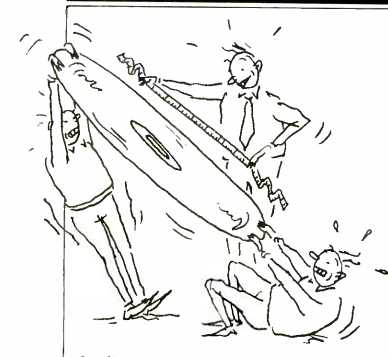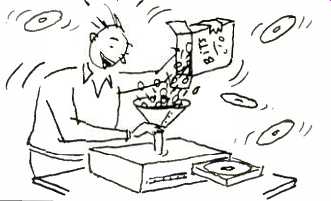ARS LONGA, AND LONGA STILL

Adding Minutes, Losing Track
The world record for the most music on a stereo CD has just been broken-so many times, this year, that I've lost track.
The first breakthrough was Telarc 80135, back in 1987, which contained 74 minutes and 23 seconds of choral music by Faure and Durufle. "The factories that make our Compact Discs tell us this is the absolute maximum amount of playing time possible with current technology," said Telarc President Robert Woods at the time. "They say you can't squeeze in another second." Well, turned out you could. A few months later, along came a BIS album (CD 145/6) containing two discs of flute works by Franz and Karl Doppler, each disc playing for 74 minutes and 50 seconds. This probably remains the longest double CD album, but longer single discs have been announced with monotonous regularity. First, BIS broke its own record with a 75:01 compilation of Sibelius piano transcriptions. Next, Telarc announced a Mozart symphony disc that clocked in at just over 77 minutes. Then Bridge Records delivered Valis, an opera by Todd 4 Machover, at 77:30--only to have the Billboard report that Angel still holds the record for classical CD length on a commercial label: Slightly more than 79 minutes on the second disc of . . . Haydn's Seasons, recorded by the Berlin Philharmonic under Herbert von Karajan." And the winner? None of the above. Rykodisc's Mission of Burma (RCD 40072) runs just over 80 minutes. (The pop music field delights in going to excess.)
To achieve these lengths, the record companies are skating on the thin edge of technology. When the CD Standard was first announced, Philips and Sony said a disc could hold about 60 minutes of music. I've heard predictions that some players will have trouble tracking all these super-long discs, though I have not heard any specific instances of such mistracking. It's still possible that someone will bring out a longer CD than Rykodisc's, but it won't be much longer. And if they do so by the time this issue goes to press, I'll just add the news as a postscript. I'm tired of rewriting this item.
--------

The War to End All Bit Wars
First, we had 16-bit CD players (and 14-bit models that used oversampling to reach 16-bit S/N ratios). Then we had quasi 18-bit players, which used bit shifting and 16-bit D/A converters to get 18-bit S/N. Hard on those players' heels came models with true 18-bit converters. Now Denon has introduced two 20-bit models, the DCD-3520 and DCD-1520-not with a fanfare, but with something like apologies for the state of the art.
According to Denon's Senior Vice President, Robert Heiblim, "For Denon, it's uncomfortable to have a big number, because we don't like to hang our hat on specifications. We don't want to start a bit war. We know hat an endless procession of higher bit and higher oversampling CD players is no guarantee of better sound. The important thing is to deliver the best 16-bit system possible. The 20-bit system is our solution for today. But if we ever get perfect 16-bit converters, there will be no need for anything more, and this numbers race will end."
--------
Will CDs Get the Blues?
The amount of information that can fit on a CD depends on the size of the pits encoding that information, and the size of the pits depends on the wavelength of the laser reading them. The smaller the wavelength, the smaller the pits can be.
The CD Standard is based on a wavelength of 780 nanometers, in the near infrared portion of the light spectrum. One reason for this choice was the availability of fairly inexpensive, solid-state lasers which produced 780-nm light.
A recent development opens up the possibility of solid-state laser systems which would operate at half that wavelength, where large, argon-gas lasers are used currently. To generate coherent light at half the wavelength produced by the diode alone, scientists at Matsushita have teamed conventional laser diodes with an optical waveguide of hydrogen-doped lithium niobate. This would shift a 780-nm infrared laser's output to 390 nm, in the blue region.
At about $10,000, Matsushita's prototype blue laser is impractically expensive. It's also inefficient, and its output is limited to 1 mW. Eventual refinements of the device could conceivably find their way into flat color TV screens and optical disc systems.
This does not mean an instant revolution in CD technology, even when solid-state blue lasers become practical. Discs made to be read by 390-nm beams would have pits too small to be read by existing CD players, and players with only 390-nm lasers would have difficulties playing conventional CDs. A new 390-nm Standard would, however, allow 3-inch CDs to carry more music than standard-sized CDs do now, and would usually eliminate the need for multi-disc CD sets. Players compatible with both the old and new discs could be made. The catch would be convincing people to buy them.
(adapted from Audio magazine, Dec. 1988; by IVAN BERGER)
= = = =